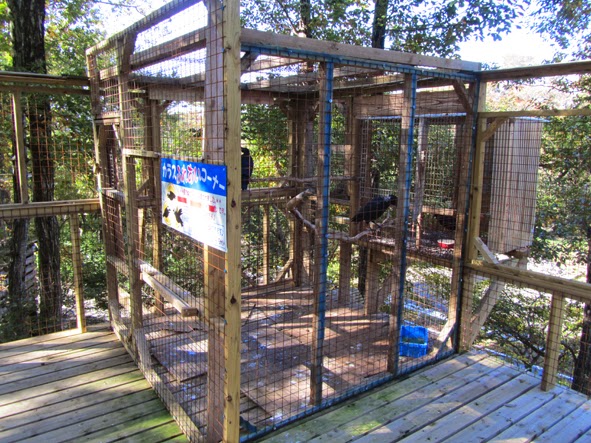In Japanese folklore, foxes are depicted as intelligent, mystical creatures that possess the ability to change their appearance - often to trick humans. After spending over five hours on a bright autumn day among well over one hundred of them at
Can
you spot the foxes hidden in the forest?
There
were many small shelters like the one below, with foxes sleeping within them
and under them.
Foxes at Very Close Range
While
the foxes at Zao Fox Village Zao Fox Village
On
this sunny day, most of the foxes spent most of the time snoozing. I could walk right up to the sleeping foxes,
and if I were inclined to risk getting bitten, I would have certainly been able
to touch them. On the occasion when a
sleeping fox sensed my approach, it might startle, raise its head, give me a
very brief look over, and then go back to sleep. These foxes are obviously accustomed to the
close presence of humans.
Some
of these foxes seem to be quite well fed.
Different Varieties
of Fox
The Zao Fox Village
Outside
of the main open area, there is a wood-framed structure housing a number of Arctic
foxes.
(Photo
April 26, 2014)
(Photo
April 26, 2014)
These
are described on the homepage as Hokkyoku
gitsune shado (Arctic fox - Shadow), and Hokkyoku gitsune buru- (Arctic fox - Blue). Unfortunately, scientific names are not
provided on either the homepage or the signs posted throughout the
facility. Noteworthy is the fact that Ezo
Red Foxes (Vulpes vulpes schrencki)
are native to the island of Hokkaido , and not the island
of Honshu where Miyagi Prefecture Zao Fox
Village , including the color
variations, were originally imported (purchased?) from Hokkaido
Lots of Foxes, Lots
of Cages
I was
unable to count how many foxes were resident in the main forest enclosure area,
but I think a lower conservative estimate would be about 50 to 70 individuals,
with an upper estimate being over 100. And
since the foxes in the main area are free to roam, they are free to interact,
and presumably to reproduce.
Besides
the foxes living in the main open area, there were also many foxes living in
cages and pens located on the southern and western perimeters of the main
area. The signs on these cages and pens
indicated that these foxes were juveniles or foxes that were receiving some
type of medical treatment.
There were 2 juvenile foxes and
1 mother in the pen in the foreground and about 11 juveniles in the pen in the
background.
There
were 9 juveniles in this set of pens.
The
structure below housed 20 juveniles.
This
photograph, taken from the opposite side of the pen, shows some of the 20
juveniles sleeping.
There
were another 11 juveniles in this pen.
The
sign above the cages below indicates that the cages are for medical treatment.
I could not get close enough to see what types of injuries the foxes had
incurred.
The
sign on the cage below states that the 2 foxes inside are Hondo kitsune, the variety native to Honshu
island (Vulpes vulpes japonica). As
far as I could see, these were the only two Hondo
kitsune residing at Zao
Fox Village
All
in all, I counted about 130 juvenile foxes in the various pens/cages located on the
property. This number does not include
the foxes roaming freely in the main open forest area. If there are at least 50 to 70 foxes in the
main enclosure area, it would mean there are at least 180 to 200 foxes residing
at this facility. An entry on Zao Fox Village
Other Animals
On the day of my Autumn visit,
I also counted 51 rabbits, 2 ponies, 7 goats, 4 crows, and 1 Japanese Badger.
These
3 crows had a main space of about 2 meters wide by 2 meters deep by 2 meters
tall with a small attached box about one-fourth of that size.
Below
is a Nihon anaguma (Japanese Badger: Meles anakuma).
Explanations and
Cautions
In This sign explains the attributes of the Kita Kitsune (Ezo Red Fox). There were similar explanatory signs for the other color variations.
This sign compares fox ages to human ages.
This sign explains the frequency of disinfecting procedures undertaken at
This sign explains the disease Chinococciasis Multilocularis and the measures taken by
This signs tells visitors to not insert their fingers into the cage.
Opportunities for
Animal Encounters
Immediately inside the
entrance of There were 2 foxes in the below cage. Visitors could carry and pose for a photo with one of these young foxes for 400 yen. Information from the blog indicated that, in usual years, these photo opportunities stop at the beginning of July. Apparently, since there were so many late born pups this year, these posing sessions continued until the end of October.
Visitors could also hold and pose with a rabbit for 100 yen.
Food and Souvenirs
(Photo
April 26, 2014)
The
souvenir shop at Zao
Fox Village
There
was a small dining area adjacent to the souvenir area, but since the kitchen
was closed when I visited this facility, I cannot report on the food offerings.
(Note:
Unless otherwise noted, the photos taken in this post were taken during a visit
on October 25, 2014. The comments in
this post are based on observations made on that day. Conditions may have since changed. Please check it out for yourself!)
Video of the foxes at Miyagi Zao Fox Village:

















































